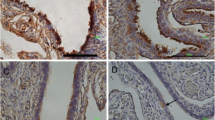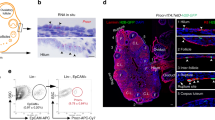Abstract
Stem cells are used to repair and regenerate multiple tissues in the adult. We have previously shown that stem cells play a significant role in mediating endometrial repair and tissue regeneration. We hypothesized that the oviduct may possess a similar population of stem cells that contribute to the maintenance of this tissue. Here we identify label-retaining cells (LRCs) in the murine oviduct which indicate the presence of a stem/progenitor cell population in this tissue as well. Two-day-old CD-1 mice were injected intraperitoneally with 5-bromo-2-deoxyuridine (BrdU) or vehicle control. Female animals (n = 36 for each group) were killed at 6 weeks post injection. Reproductive tracts were removed, specimens were embedded in paraffin, and 5-µ sections were prepared. Oviduct was identified by hematoxylin and eosin staining and morphology. Immunofluorescence studies were performed on serial sections tissues (n = 12 per animal) using antibodies against BrdU. Confocal microscopy was used to identify 4′,6-diamidino-2-phenylindole (DAPI)- and BrdU-stained nuclei. In the group of mice exposed to BrdU, we identified a population of LRCs in all specimens and not in controls. The putative stem cells are located at the base of each villi, suggesting the location of the stem cell niche. The number of DAPI-stained nuclei divided by the number of LRCs; LRCs constituted 0.5% of all nucleated cells. The oviduct contains a population of progenitor cells, likely used in the repair and regeneration of fallopian tube. Defective or insufficient stem cell reserve may underlie common tubal diseases, including hydrosalpinx and ectopic pregnancy.
Similar content being viewed by others
References
Moore KA, Lemischka IR. Stem cells and their niches. Science. 2006;311(5769):1880–1885.
Challen GA, Little MH. A side order of stem cells: the SP phenotype. Stem Cells. 2006;24(1):3–12.
Blanpain C, Horsley V, Fuchs E. Epithelial stem cells: turning over new leaves. Cell. 2007;128(3):445–458.
Chan RW, Gargett CE. Identification of label-retaining cells in mouse endometrium. Stem Cells. 2006;24(6):1529–1538.
Potten CS, Owen G, Booth D. Intestinal stem cells protect their genome by selective segregation of template DNA strands. J Cell Sci. 2002;115(pt 11):2381–2388.
Gargett CE. Uterine stem cells: what is the evidence? Hum Reprod Update. 2007;13(1):87–101.
Li L, Clevers H. Coexistence of quiescent and active adult stem cells in mammals. Science. 2010;327(5965):542–545.
Massasa EE, Taylor HS. Use of endometrial stem cells in regenerative medicine. Regen Med. 2012;7(2):133–135.
Du H, Naqvi H, Taylor HS. Ischemia/reperfusion injury promotes and granulocyte-colony stimulating factor inhibits migration of bone marrow-derived stem cells to endometrium. Stem Cells Dev. 2012;21(18):3324–3331.
Santamaria X, Massasa EE, Feng Y, Wolff E, Taylor HS. Derivation of insulin producing cells from human endometrial stromal stem cells and use in the treatment of murine diabetes. Mol Ther. 2011;19(11):2065–2071.
Du H, Taylor HS. Contribution of bone marrow-derived stem cells to endometrium and endometriosis. Stem Cells. 2007; 25(8):2082–2086.
Taylor HS. Endometrial cells derived from donor stem cells in bone marrow transplant recipients. JAMA. 2004;292(1): 81–85.
Wolff EF, Gao XB, Yao KV, et al. Endometrial stem cell transplantation restores dopamine production in a Parkinson’s disease model. J Cell Mol Med. 2011;15(4):747–755.
Wolff EF, Wolff AB, Hongling D, Taylor HS. Demonstration of multipotent stem cells in the adult human endometrium by in vitro chondrogenesis. Reprod Sci. 2007;14(6):524–533.
Chan RW, Kaitu’u-Lino T, Gargett CE. Role of label-retaining cells in estrogen-induced endometrial regeneration. Reprod Sci. 2012;19(1):102–114.
Chan RW, Schwab KE, Gargett CE. Clonogenicity of human endometrial epithelial and stromal cells. Biol Reprod. 2004; 70(6):1738–1750.
Masuda H, Anwar SS, Buhring HJ, Rao JR, Gargett CE. A novel marker of human endometrial mesenchymal stem-like cells. Cell transplant. 2012;21(10):2201–2214.
Schwab KE, Gargett CE. Co-expression of two perivascular cell markers isolates mesenchymal stem-like cells from human endometrium. Hum Reprod. 2007;22(11):2903–2911.
Wang Y, Sacchetti A, van Dijk MR, et al. Identification of quiescent, stem-like cells in the distal female reproductive tract. PloS One. 2012;7(7):e40691.
Jazedje T, Perin PM, Czeresnia CE, et al. Human fallopian tube: a new source of multipotent adult mesenchymal stem cells discarded in surgical procedures. J Transl Med. 2009;7:46.
Kessler M, Zielecki J, Thieck O, Mollenkopf HJ, Fotopoulou C, Meyer TF. Chlamydia trachomatis disturbs epithelial tissue homeostasis in fallopian tubes via paracrine Wnt signaling. Am J Pathol. 2012;180(1):186–198.
Paik DY, Janzen DM, Schafenacker AM, et al. Stem-like epithelial cells are concentrated in the distal end of the fallopian tube: a site for injury and serous cancer initiation. Stem Cells. 2012; 30(11):2487–2497.
Author information
Authors and Affiliations
Corresponding author
Rights and permissions
About this article
Cite this article
Snegovskikh, V., Mutlu, L., Massasa, E. et al. Identification of Putative Fallopian Tube Stem Cells. Reprod. Sci. 21, 1460–1464 (2014). https://doi.org/10.1177/1933719114553448
Published:
Issue Date:
DOI: https://doi.org/10.1177/1933719114553448




